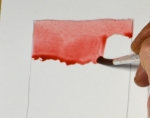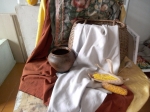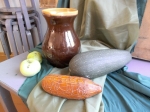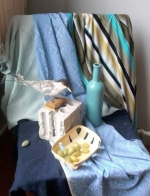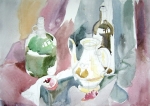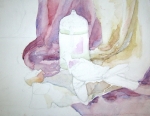This text is written by a practising artist and the teacher of Gomel State Art College (Belarus) Sviatlana Kurashova. There are used photos of works by students of Gomel State Art College.
A simple list of some technological methods of watercolor painting on can be found in the section "Technology" >>>
...introduction…
This guide is an extract from the methodological works of the author, which is based on her own twenty-year pedagogical experience in art college and traditional method of teaching watercolor painting.
The technique of teaching watercolor painting is well known to the author as a watercolor artist. The guide is illustrated with the students' works, photos of the watercolor making process and the author's works. Teaching watercolor has its own characteristics: the position of the easel; working from light to dark; a number of specific techniques that are impossible in any other pictorial techniques. The author avoids to describe the process of working over each program task in details but focuses on:
- important first steps in mastering watercolor skills;
- specifics of watercolor painting in art college;
- the system of homework within one-year course of watercolor painting based on her own experience.
The main educational task at watercolour studying is a long time sketch drawing from nature. The tasks of the educational still-lifes are given in a certain sequence and tend to be constantly complicated. Each still-life has its own tasks.
At the beginning of the training course it is important to draw the students' attention to the development of pictorial vision of nature, the sense of beauty and colour harmony, the skills of colour perception, the practical ability to work with color and tone relations, the cohesiveness of nature and sketch understanding.
You often can hear at the first class "I’ve never used watercolor but I heard it is a very complex technique." Yes, indeed, watercolor is based on water and has all particular features of water. It can be unpredictable. But if you master and love its features you will be able to control it.
Exercise "filling".
| The basic exercise is an equal fill (architects call it "a wash drawing"). To do this exercise you should make at pallet rather rich mix of color and water. The brush should just contacts it. (Don't put the brush into water or color any more.) Work starts at the top of paper and goes down (according with the law of universal gravitation and not contrary). The brush should contain nough colour solution and you just “help” it to be spreaded over the paper. Fill with colour a few rectangles until you get a well-done regular surface. |
Exercise “gradient” or “shading-off”.
| Next, you should do exercises for "shading-off" the color to almost white paper and vice versa - from transperant water to color. |
Exercise "soldering" one color into another.
| Next exercize is the "soldering" one color into another color. Here you can also practice in a cetain gamma (warm or cold). |
Exercise "Increasing the density" of the paint layer.
| Take one of the dried rectangles that you've filled with one color. Divid it into 4 parts but not with the help of more intensive colour but "glazing" it again and again over the made ones with a thin layer of colour and trying to get different ranges of colour intensity. |
Exercises "strokes".
| Next, cover the dry sheet of paper with individual strokes using a large brush and slightly covering each other. |
| Then cover the dry sheet with transparent strokes leaving small areas of white paper untouched. |
Watercolor has o lot of different techniques. But should you try them without practicaly fixing the basic knowledges? However, to make the work more interesting, you can try using paraffin and salt.
Exercise "salt".
| On the flat and wet section of watercolor we pour salt. (You can use salt of both small and coarse grinding) |
Exercises "paraffin" or 'wax'.
| We cover with paraffin (wax) those pieces of paper that we want to leave unpainted. Next, we put watercolor directly on top of the paraffin pattern. |
When you did these exercises you can start simple sketchs.
THE FIRST STEPS IN WATERCOLOR
You can use as nature for your sketches the ordinary vegetables and fruits: apples, pears, beets, cucumbers, tomatoes, cabbage, etc.
Task: to transfer color-tonality relations, "to model" the volume of objects with color, keeping in mind its background and the falling shadow.
As we start from the point that you know how to depict the volume of objects, pay attention to the nature of lighting; the difference between light and shadow; the presence of reflexes.
Typical mistakes in such sketchs:
- work from the contour;
- weak tone relations;
- use of "open" colors (not mixed);
- absence of connection with the background.
First still-lifes usually consist of a small number of objects simple in form, expressive in color, on a single-colored drapery that emphasizes the expressiveness of objects. In other words - from simple to complex.
At the early stages of watercolor studying students have no a solid "knowledge of checkered light and shade" and "tonal drawing" skills. It is difficult for them to depict the general shape and materiality of objects in color. So it is important to pay serious attention at the preparatory drawing and carefully build the shapes of the objects.
It makes sense to do the first sketches in the technique of “grisaille” (a painting made entirely in shades of grey or of another neutral greyish colour). It will help to better understand "tone", "space" and "checkered light and shade".
Ideally, natural still-lifes should be put by teachers in a certain sequence. Each of them should contain certain training tasks. The complication of a still-life means not to increas the number of objects, but to increas requirements for form, color, light-air space.
Doing a starting drawing you can a little bit spoil the structure of paper and its whiteness. Therefore in watercolor it is possible to do the drawing on one paper and the “move” it to the main format of watercolor paper.
Watercolor is supposed to be a complicated technique. This point of view has its reasons:
- watercolor has no white color. Instead of it we use the whitness of paper. It is possible due to the transperance of colour layes;
- corrections are mostly not possible. The paper firmly holds the color layer;
- paper, even of the highest quality, has its own "limit of patience". It is very easy to spoil the picture with the odd color layes.
Nevertheless, in watercolor ot is possible to correct and improve pictures, and its difficulties are compensated by the unique properties (not possible in any other material).
As a rule, at the very start there appear a reasonable question – with what to start?
It must be said that, on the one hand, the process chain can be individual, and on the other - it is necessary to immediately develop a professional approach to the start of work. You should start with the search of the main color and tone relations. Typically, the color of the picture is determined by a combination of 2-3 main color spots, which are enriched with their shades and combined with others colors.
The main difference of watercolor and other paints such as oil and gouache – in watercolour the work goes from light to dark. In addition, it is always worth to leave one spot uncovered and white. It will show the maximum intensity of light coming from the white paper.
In practice, many students start to paint with the big spots at the background, as they are afraid to spoil more important parts of a picture. We don’t stop them, as the ability to paint “wide” is also important. In such method you can work with wide areas of filling, using gradients, soldering color into color, and you can try to work "A La Prima" by wetting a large area with the brush. Students are braver working in the distant view and they practice these skills easier.
To paint a close-up view we should use a different approach. Here we make better detalization, make contrasts more vivid, the shapes of the objects and drapery more demonstrative. In this case, we recommend working with the dry surface of the sheet using small fillings or strokes around the shape. Some of these skills you’ve got doing the first sketches.
Studding watercolor it is very important to use visual material. We can recommend you the following:
- Watercolors by Mikhail Vrubel and other well-known artists;
- View a number of professional publications on contemporary watercolor.
- To study the works participating in the largest watercolor exhibitions such as the fair SALON DE L'Aquarelle-de Belgique. In our country it is the Biennale "Wada + Farba".


